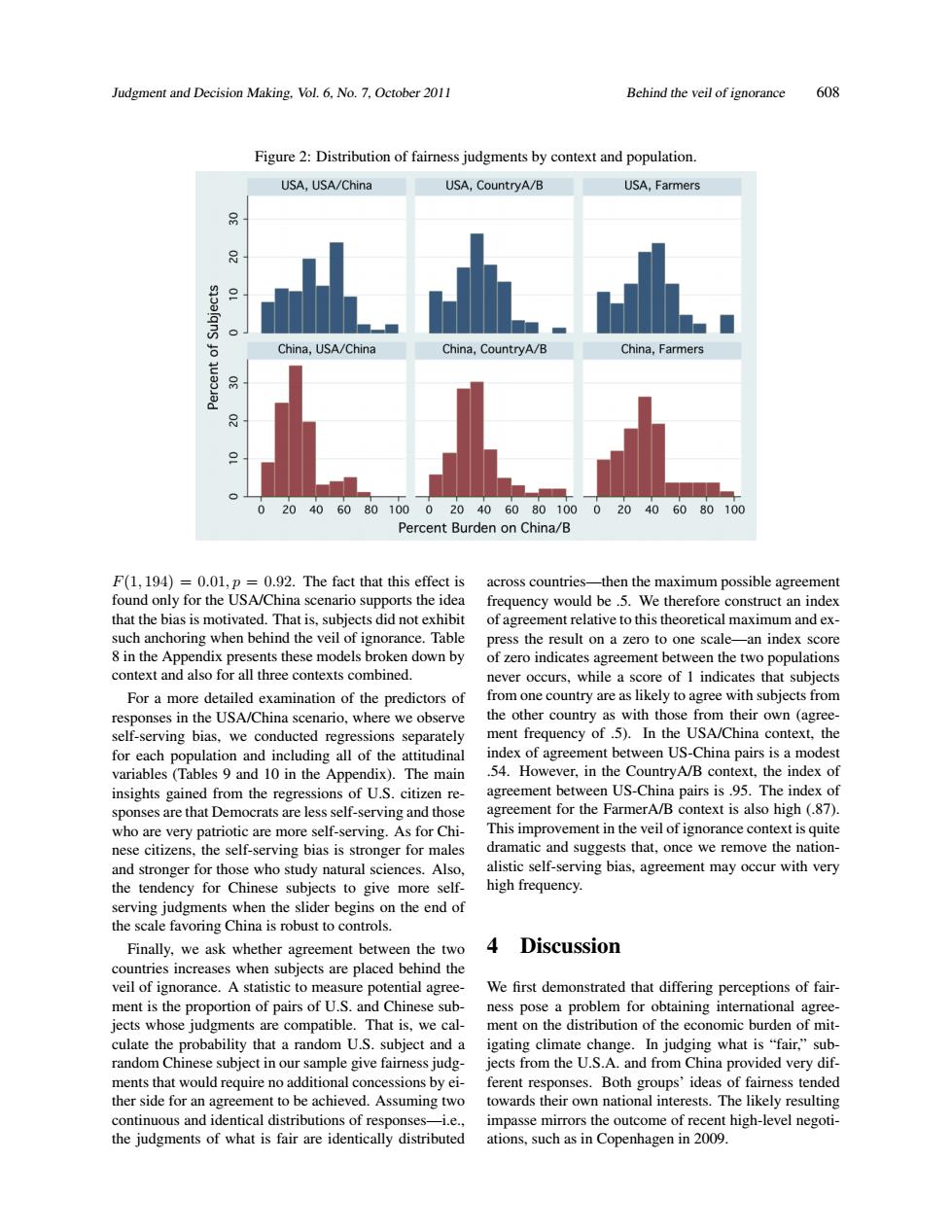正在加载图片...

Judgment and Decision Making,Vol.6.No.7.October 2011 Behind the veil of ignorance 608 Figure 2:Distribution of fairness judgments by context and population USA.USA/China USA,CountryA/B USA,Farmers China,USA/China China,CountryA/B China,Farmers 2040608010 rder on Chi 01=00 then the maxim rts the idea ss countri um pe ossible agre ld he 5 We that the bias is motivated.That is,subjects did not exhibit of agreement relative to this theoretical maximum and ex- uch anchoring when behind the veil of ignorance.Table 8 in the se mod down by zero indicat of 1 ind he two population e a For a more amination of the predi fors of the other country as with those from their own (a ment frequency of.5).In the USA/China context,the for each population and including a of the attitudina China pairs is a modes variables (Tables9 and 10 in the Appendix). The main ever,in t 10n of U zen re US.CL This improvement in the veil of ignorance context is quite dramatic and suggests that,once we remove the nation ency for Ch to give more frequency the the end of Finally,we as agreement b 4 Discussion ance statistic to measure potentialagre We first demonstrated that differing perceptions of fair- ment is the proportion of pairs of u.s.and chinese sub. ness pose a problem for obtaining international agree. ects whose judgments are compatible That is.we ca ment on the distribution of the economic burden of mit ulate the pro ty that a random ging what is that would r idea of fai ther side for an agreement to be achieved.Assuming two towards their own nation interest.The likely resultin 1.e. Judgment and Decision Making, Vol. 6, No. 7, October 2011 Behind the veil of ignorance 608 Figure 2: Distribution of fairness judgments by context and population. F(1, 194) = 0.01, p = 0.92. The fact that this effect is found only for the USA/China scenario supports the idea that the bias is motivated. That is, subjects did not exhibit such anchoring when behind the veil of ignorance. Table 8 in the Appendix presents these models broken down by context and also for all three contexts combined. For a more detailed examination of the predictors of responses in the USA/China scenario, where we observe self-serving bias, we conducted regressions separately for each population and including all of the attitudinal variables (Tables 9 and 10 in the Appendix). The main insights gained from the regressions of U.S. citizen responses are that Democrats are less self-serving and those who are very patriotic are more self-serving. As for Chinese citizens, the self-serving bias is stronger for males and stronger for those who study natural sciences. Also, the tendency for Chinese subjects to give more selfserving judgments when the slider begins on the end of the scale favoring China is robust to controls. Finally, we ask whether agreement between the two countries increases when subjects are placed behind the veil of ignorance. A statistic to measure potential agreement is the proportion of pairs of U.S. and Chinese subjects whose judgments are compatible. That is, we calculate the probability that a random U.S. subject and a random Chinese subject in our sample give fairness judgments that would require no additional concessions by either side for an agreement to be achieved. Assuming two continuous and identical distributions of responses—i.e., the judgments of what is fair are identically distributed across countries—then the maximum possible agreement frequency would be .5. We therefore construct an index of agreement relative to this theoretical maximum and express the result on a zero to one scale—an index score of zero indicates agreement between the two populations never occurs, while a score of 1 indicates that subjects from one country are as likely to agree with subjects from the other country as with those from their own (agreement frequency of .5). In the USA/China context, the index of agreement between US-China pairs is a modest .54. However, in the CountryA/B context, the index of agreement between US-China pairs is .95. The index of agreement for the FarmerA/B context is also high (.87). This improvement in the veil of ignorance context is quite dramatic and suggests that, once we remove the nationalistic self-serving bias, agreement may occur with very high frequency. 4 Discussion We first demonstrated that differing perceptions of fairness pose a problem for obtaining international agreement on the distribution of the economic burden of mitigating climate change. In judging what is “fair,” subjects from the U.S.A. and from China provided very different responses. Both groups’ ideas of fairness tended towards their own national interests. The likely resulting impasse mirrors the outcome of recent high-level negotiations, such as in Copenhagen in 2009